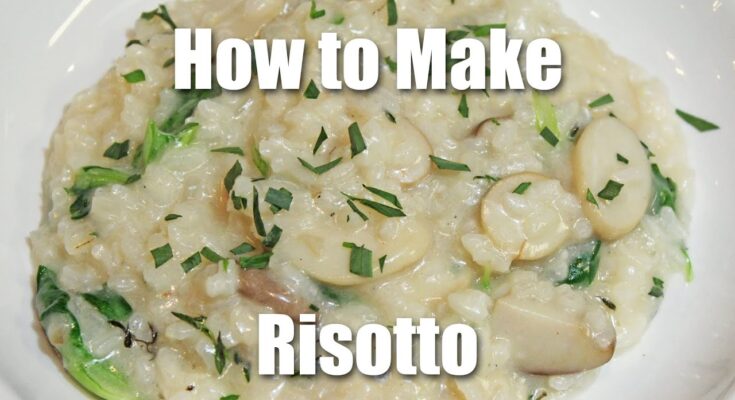Risotto Recipe: Risotto is the beloved Italian comfort dish that graces tables from Italy to all corners of the world. Made with short-grain rice, risotto is known for its creamy, velvety consistency, blending the earthy taste of broth with aromatic herbs, fresh vegetables, or sometimes seafood. Though it may look complex, mastering risotto at home is much simpler than it seems, especially with this step-by-step guide.
What is Risotto?
Risotto is a northern Italian rice dish that becomes creamy and rich through a unique cooking technique. Unlike many rice-based dishes, risotto requires a type of short-grain rice that releases starch as it cooks. The result? A lusciously creamy dish that feels decadent without needing heavy cream.
History and Origins of Risotto
Originating in northern Italy, particularly in the Lombardy and Veneto regions, risotto is said to have appeared as far back as the 14th century. Rice cultivation thrived in this area due to the favorable climate, making rice a staple ingredient. Over time, risotto became synonymous with Italian cuisine, particularly in dishes where local ingredients like mushrooms, truffles, and cheese play a starring role.
Why Risotto is Loved Worldwide
Risotto’s appeal lies in its versatility and indulgent flavor. From savory mushroom risottos to seafood and even vegetable-based versions, it’s a dish that allows creativity while satisfying cravings for comfort food. Plus, its rich and creamy texture feels both light and filling, making it a favorite side or main course for various meals.
Key Ingredients for Risotto
Selecting the Right Rice
The type of rice used is the cornerstone of any good risotto. Not all rice varieties are created equal, and using the wrong kind can dramatically alter the outcome. Short-grain rice varieties like Arborio, Carnaroli, and Vialone Nano are ideal for risotto because they have a high starch content, which gives risotto its signature creamy texture.
Arborio, Carnaroli, and Vialone Nano – The Best Rice Varieties
- Arborio: The most widely available and commonly used rice for risotto, Arborio is known for its plump grains and excellent starch release.
- Carnaroli: Often referred to as the “king” of risotto rice, Carnaroli has a slightly firmer texture and is preferred by many chefs for its consistency and creamy texture.
- Vialone Nano: Known for its superior creaminess, Vialone Nano is often used in Italy for traditional risottos and is excellent for achieving the perfect al dente texture.
Essential Ingredients Beyond Rice
While rice is the star of the show, other ingredients play supporting roles that enhance risotto’s flavor and texture.
Broth, Butter, Cheese, and Wine
- Broth: Chicken or vegetable broth is essential as it infuses the rice with flavor. Homemade broths are ideal, but high-quality store-bought versions work well too.
- Butter: Added at the end of cooking, butter enriches the risotto, making it smooth and glossy.
- Cheese: Parmesan or Pecorino Romano cheese is stirred in to add depth and savoriness.
- Wine: A splash of white wine deglazes the pan, adding a hint of acidity that balances the richness of the dish.
Essential Tools Needed for Cooking Risotto
Choosing the Right Pan and Ladle
Using a wide, heavy-bottomed pan is key to ensuring even cooking and preventing the rice from sticking. A ladle is also essential for gradually adding broth, allowing you to control the amount of liquid to achieve the right consistency.
Other Handy Kitchen Tools
Other useful tools include a wooden spoon (ideal for stirring without breaking the rice grains), a measuring cup for broth, and a good grater for freshly grating cheese.
Step-by-Step Guide to Making the Perfect Risotto
Step 1 – Prepare the Ingredients
Before starting, measure out all ingredients, ensuring everything is within reach. This includes pre-measuring your rice, dicing onions, mincing garlic, and grating cheese. When making risotto, timing is essential, and having everything ready keeps the process smooth.
Measuring Ingredients Properly
The standard ratio is one cup of rice to about three to four cups of broth. However, this may vary depending on the type of rice, so it’s best to have extra broth on hand.
Step 2 – Prepare the Broth
Heat the broth in a saucepan on medium heat, keeping it at a low simmer. Adding warm broth to the rice helps it absorb the liquid faster and keeps the temperature consistent throughout the cooking process.
Step 3 – Sauté the Aromatics
In your wide pan, add a tablespoon of olive oil and a small amount of butter. Once melted, add diced onions and garlic. Sauté over medium heat until they become translucent, enhancing the risotto’s base flavor.
Tips for Sautéing Onions and Garlic
Cook onions slowly on low to medium heat to avoid burning, as burnt onions can add bitterness to the risotto. Add garlic toward the end of sautéing since it cooks much faster and can become bitter if overcooked.
Step 4 – Toast the Rice
Add the rice to the pan with the aromatics and stir it constantly for about two minutes. Toasting the rice lightly before adding liquid enhances the depth of flavor and helps the rice maintain its structure.
Step 5 – Deglaze with Wine
Pour in a splash of white wine (about 1/4 cup), stirring until the wine is mostly absorbed. The wine adds a lovely hint of acidity, balancing out the richness of the rice.
Step 6 – Add the Broth Gradually
Now, begin the gradual process of adding broth. Pour one ladle of broth into the rice at a time, stirring continuously until the liquid is almost absorbed before adding the next ladle. This technique releases the starch from the rice, creating the creamy texture.
Stirring Tips and Techniques
Stirring is crucial in risotto. Constant stirring prevents sticking, evenly distributes heat, and encourages the rice to release its starch, creating the signature creamy texture. Stir gently to avoid breaking the grains.
Step 7 – Finish with Butter and Cheese
Once the rice is tender with a slight al dente bite, remove the pan from heat. Stir in a knob of butter and a generous handful of grated Parmesan cheese. This final step adds extra creaminess and gives the risotto a glossy finish.
Tips for Achieving the Perfect Risotto Texture
Perfecting risotto involves careful attention to timing, temperature, and consistency. Here are some tips to ensure a dish with the ideal texture.
Timing and Temperature Tips
The cooking process typically takes about 18-20 minutes from when the rice starts absorbing broth. Cooking at a medium temperature helps the rice cook evenly without becoming mushy or undercooked. Too high a temperature can evaporate the broth too quickly, and too low a temperature may lead to a gummy texture.
Consistency and Creaminess Tips
Risotto should be creamy, with each grain distinct. If it becomes too thick or dry, add an extra ladle of broth and stir until the desired consistency is reached. For added creaminess, stir in a little extra butter or cheese at the end.
Common Variations of Risotto
One of the best things about risotto is how adaptable it is. Here are some popular variations you can try to bring new flavors to the dish.
Mushroom Risotto
Mushroom risotto is a classic variation, perfect for those who enjoy earthy flavors. Use a mix of fresh and dried mushrooms for a deep, savory taste. Sauté the mushrooms separately and stir them into the risotto toward the end to preserve their texture.
Seafood Risotto
Seafood risotto, or “risotto ai frutti di mare,” combines tender shrimp, scallops, and calamari. For the best results, use a seafood broth and add the seafood during the last few minutes of cooking to keep it tender.
Vegetable Risotto
A vegetable risotto is ideal for a lighter, fresher flavor. Common vegetables include asparagus, peas, spinach, and zucchini. Add vegetables like peas or asparagus in the final minutes to maintain their color and texture.
Pairing Your Risotto with Sides and Beverages
Enhance your risotto meal with the right sides and wine pairings to complete the experience.
Choosing the Best Sides
For sides, consider a light green salad, garlic bread, or roasted vegetables. Avoid heavy sides since risotto itself is rich. Fresh, crisp sides balance the creaminess and create a harmonious meal.
Ideal Wine Pairings
The wine you cook with can also be enjoyed alongside the meal. White wines like Pinot Grigio, Sauvignon Blanc, or Chardonnay are wonderful choices. For more robust risottos with red sauces or mushrooms, a light red wine like Pinot Noir or Sangiovese complements the dish well.
Troubleshooting Common Risotto Problems
It’s common to encounter a few issues while making risotto. Here’s how to solve the most common problems.
Risotto Too Thick or Thin
If your risotto is too thick, simply add a bit more broth, stirring until it reaches the desired consistency. If it’s too thin, continue cooking and stirring for a few extra minutes to evaporate the excess liquid.
Rice Not Fully Cooked
If the rice is undercooked, add a little extra broth and cook for a few more minutes, stirring constantly. Check the rice every few minutes until it reaches the perfect tenderness.
Risotto Too Sticky or Watery
If your risotto is too sticky, it may have been over-stirred or cooked at a low temperature. Increasing the heat slightly and adding a bit of warm broth can sometimes loosen the texture. Watery risotto is often due to adding too much liquid at once; be sure to add it gradually.
Storing and Reheating Leftover Risotto
While risotto is best enjoyed fresh, it’s possible to store and reheat leftovers with the right technique.
Proper Storage Techniques
Store leftover risotto in an airtight container in the refrigerator for up to two days. Risotto can be quite perishable, so it’s essential to store it properly to avoid spoilage.
Reheating Tips for Retaining Texture and Flavor
To reheat, add a splash of broth or water to the risotto and warm it over low heat on the stove. Stir continuously until it regains its creamy consistency. Microwaving can dry it out, so reheating on the stove is preferable for the best texture.
Health Benefits of Risotto and Nutritional Information
Risotto is a carbohydrate-rich dish that provides energy and contains vitamins and minerals from its ingredients. When made with vegetables, lean proteins, and low-sodium broth, risotto can be part of a balanced diet. Arborio rice is an excellent source of dietary fiber, which helps with digestion, and the added vegetables offer vitamins and antioxidants. Although risotto can be high in calories due to butter and cheese, adjusting portions and ingredients makes it a versatile dish that fits into many dietary preferences.
FAQs about Risotto Recipe
What is Risotto?
Risotto is a creamy Italian rice dish made by slowly cooking rice in broth until it reaches a rich, velvety texture. It’s often flavored with ingredients like Parmesan, mushrooms, saffron, and herbs, making it a comforting and customizable meal.
What type of rice is best for Risotto?
The best rice for risotto is Arborio, Carnaroli, or Vialone Nano. These types have high starch content, which creates the desired creamy consistency. Arborio is widely available and commonly used, but Carnaroli is often preferred by chefs for its slightly firmer texture.
How do you make Risotto creamy?
To achieve a creamy risotto, cook the rice slowly, stirring frequently, and adding warm broth gradually. The starch released from the rice thickens the dish. Finishing with a bit of butter and Parmesan cheese also adds to its richness.
Can you make Risotto without broth?
Yes, though broth enhances flavor, you can substitute it with water in a pinch. Adding seasonings and aromatics like onions, garlic, and a splash of white wine can help elevate the flavor when not using broth.
Is Risotto gluten-free?
Yes, risotto is naturally gluten-free when made with rice, broth, and gluten-free ingredients. Just be cautious with any added ingredients, like store-bought broths, which may contain gluten.
Conclusion
Making risotto may seem challenging, but with the right ingredients, tools, and techniques, anyone can achieve a restaurant-quality dish at home. By following this step-by-step guide and practicing a bit of patience, you’ll be rewarded with a bowl of creamy, flavorful risotto. Whether it’s a special occasion or a comforting meal, risotto is always a delicious choice. Try experimenting with different flavors and ingredients to make it uniquely yours!
References
To ensure accuracy and provide additional resources for exploring risotto recipes, we’ve gathered a selection of reputable sources. These references offer deeper insights into various risotto techniques, ingredient choices, and expert tips, providing readers with a well-rounded understanding of this classic dish. For those looking to refine their risotto skills or experiment with new variations, the following sources are highly recommended:
- Serious Eats: Risotto Basics – A comprehensive guide covering essential risotto techniques, including the perfect rice type and stirring methods.
- Bon Appétit: Mastering Risotto – Tips and tricks from professional chefs on achieving creamy texture and balanced flavors.
- The Kitchn: Classic Risotto Recipe – Step-by-step instructions with tips for creating a fail-proof risotto at home.
- BBC Good Food: Authentic Italian Risotto – Traditional Italian recipes and variations for those who want to try regional takes on risotto.
Each source has been selected to provide readers with reliable, in-depth information for enhancing their risotto-making journey.



